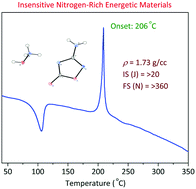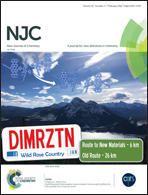3-Amino-1,2,4(4H)-oxadiazol-5-one (AOD) and its nitrogen-rich salts: a class of insensitive energetic materials†
Abstract
The targeted energetic material 3-amino-1,2,4(4H)-oxadiazol-5-one (AOD) was synthesized from sodium dicyanamide using hydroxylamine hydrochloride in a one-step procedure. AOD was prepared by a novel procedure in good yield and characterized using spectroscopic (IR, Raman, NMR) techniques. The high nitrogen-containing hydroxylamine and hydrazine salts of AOD (3) were prepared from their respective nitrogen bases in good yields. The solid state structures of the synthesized molecules were confirmed by single X-ray crystallography. 3-Amino-1,2,4(4H)-oxadiazol-5-one (AOD, 3), 3-amino-1,2,4(4H)-oxadiazol-5-one-hydroxylamine (AOD-HyAm, 5) and 3-amino-1,2,4(4H)-oxadiazol-5-one-hydrazine (AOD-Hy, 6) showed densities of 1.76, 1.73 and 1.64 g cc−1 respectively. The thermal stabilities of the molecules were assessed by thermogravimetric analysis. Non-isothermal kinetics was performed on the molecules to derive the activation energy. Constant volume combustion energy was determined using oxygen bomb calorimetry and the heat of formation was calculated from the experimental values. Sensitivities of the molecules were measured by using impact and friction tests.



 Please wait while we load your content...
Please wait while we load your content...